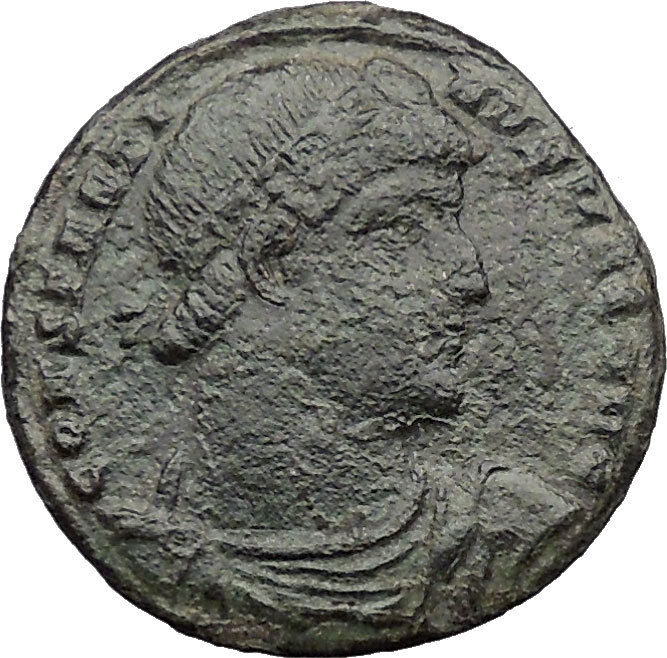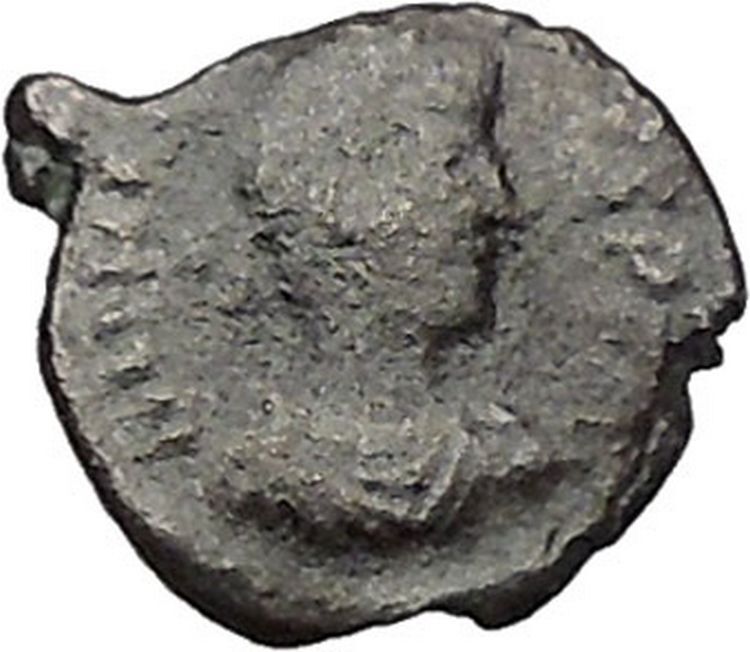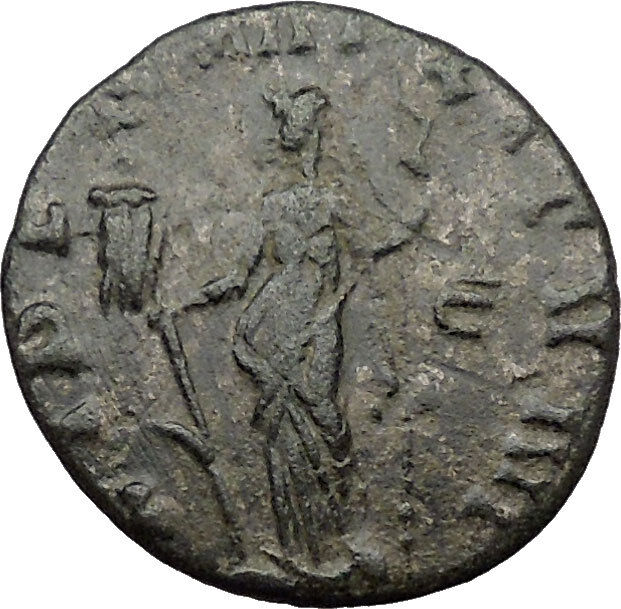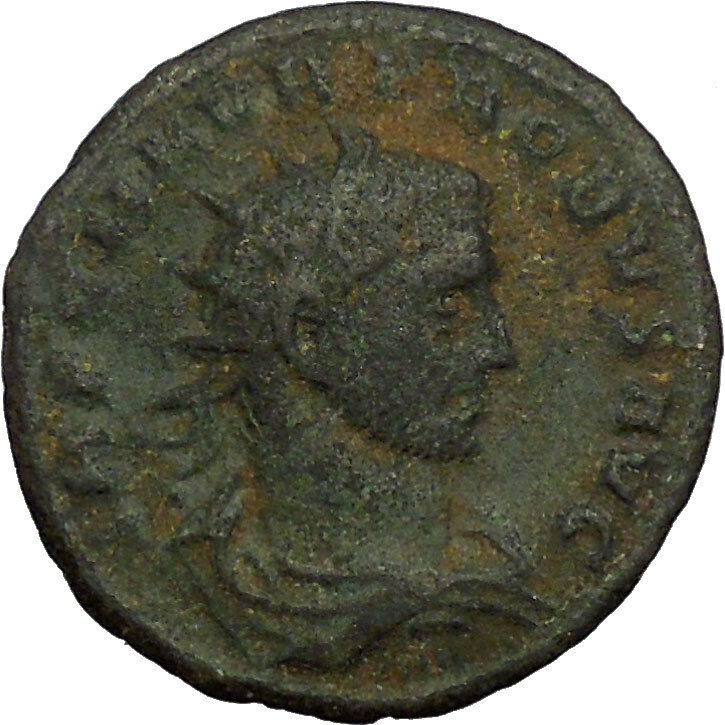|
Valerian I – Roman Emperor: 253-260 A.D.
Silver Antoninianus 22mm (3.49 grams) Struck circa 254-256 A.D.
Reference: RIC 92; RSC 94; Sear5 9943; Sear’88 #2884
IMP C P LIC VALERIANVS AVG, radiate & draped bust right
IOVI CONSERVATORI, Jupiter standing left holding sceptre & thunderbolt.
You are bidding on the exact item pictured,
provided with a Certificate of Authenticity and Lifetime Guarantee of
Authenticity.
In
Roman mythology
,
Jupiter
or
Jove was the
king of the gods
, and the god of
sky and
thunder
. He
is
 the equivalent of Zeus the equivalent of Zeus
in the
Greek pantheon
. He was called Iuppiter (or Diespiter)
Optimus Maximus (“Father God the Best and Greatest”). As the patron deity of
ancient
Rome
, he ruled over laws and social order. He was the chief god of the
Capitoline Triad
, with sister/wife
Juno
. Jupiter is also the father of the god
Mars
with Juno. Therefore, Jupiter is the grandfather of
Romulus and Remus
, the legendary founders of Rome. Jupiter was venerated in
ancient Roman religion
, and is still venerated in
Roman Neopaganism
. He is a son of
Saturn
, along with brothers
Neptune
and
Pluto
.
He is also the brother/husband of
Ceres
(daughter of Saturn and mother of
Proserpina
),
brother of Veritas
(daughter of Saturn), and father of
Mercury
.
VALERIAN I

Augustus:
A.D. 253-260 with Gallienus
Husband of Mariniana
Father of Gallienus
Grandfather of Valerian II and Saloninus
Publius Licinius Valerianus (c. 200 – after 260),
commonly known in
English
as Valerian or Valerian I,
was the
Roman Emperor
from 253 to 260.
Unlike the majority of the pretenders during the
Crisis of the Third Centuryy
, Valerian was of a
noble and traditional
senatorial
family. Details of his early life
are elusive, but for his marriage to
Egnatia Mariniana
, who gave him two sons: later
emperor Publius Licinius Egnatius Gallienus
and
Valerianus Minor
.
In 238 he was
princeps senatus
, and
Gordian I
negotiated through him for Senatorial
acknowledgement for his claim as emperor. In 251, when
Decius
revived the censorship with legislative
and executive powers so extensive that it practically embraced the civil
authority of the emperor, Valerian was chosen
censor
by the Senate, though he declined to
accept the post. Under Decius he was nominated governor of the
Rhine
provinces of
Noricum
and
Raetia
and retained the confidence of his
successor,
Trebonianus Gallus
, who asked him for
reinforcements to quell the rebellion of
Aemilianus

Coin of
Egnatia Mariniana
, wife of Valerian
and mother of
Gallienus
.
Rule and fall
Valerian’s first act as emperor was to make his son Gallienus
his colleague. In the beginning of his reign the affairs in Europe went from bad
to worse and the whole West fell into disorder. In the East,
Antioch
had fallen into the hands of a
Sassanid
vassal,
Armenia
was occupied by
Shapur I
(Sapor). Valerian and Gallienus split
the problems of the empire between the two, with the son taking the West and the
father heading East to face the
Persian
threat.
By 257, Valerian had already recovered Antioch and returned
the province of
Syria
to Roman control but in the following
year, the Goths
ravaged
Asia Minor
. Later in 259, he moved to
Edessa
, but an outbreak of
plague
killed a critical number of
legionaries
, weakening the Roman position in
Edessa which was then besieged by the Persians. At the beginning of 260,
Valerian was defeated in the
Battle of Edessa
and he arranged a meeting with
Shapur to negotiate a peace settlement. The ceasefire was betrayed by Shapur who
seized him and held him prisoner for the remainder of his life. Valerian’s
capture was a humiliating defeat for the Romans.
Gibbon
, in
The History of the Decline and Fall of the Roman Empire
describes Valerian’s fate:
The voice of history, which is often little more than the
organ of hatred or flattery, reproaches Sapor with a proud abuse of the
rights of conquest. We are told that Valerian, in chains, but invested with
the Imperial purple, was exposed to the multitude, a constant spectacle of
fallen greatness; and that whenever the Persian monarch mounted on
horseback, he placed his foot on the neck of a Roman emperor.
Notwithstanding all the remonstrances of his allies, who repeatedly advised
him to remember the vicissitudes of fortune, to dread the returning power of
Rome, and to make his illustrious captive the pledge of peace, not the
object of insult, Sapor still remained inflexible. When Valerian sunk under
the weight of shame and grief, his skin, stuffed with straw, and formed into
the likeness of a human figure, was preserved for ages in the most
celebrated temple of Persia; a more real monument of triumph, than the
fancied trophies of brass and marble so often erected by Roman vanity. The
tale is moral and pathetic, but the truth of it may very fairly be called in
question. The letters still extant from the princes of the East to Sapor are
manifest forgeries; nor is it natural to suppose that a jealous monarch
should, even in the person of a rival, thus publicly degrade the majesty of
kings. Whatever treatment the unfortunate Valerian might experience in
Persia, it is at least certain that the only emperor of Rome who had ever
fallen into the hands of the enemy, languished away his life in hopeless
captivity.
Valerian’s massacre of 258
According to the
Catholic Encyclopedia
article on
Valerian
:
Pope Sixtus
was seized on 6 August, 258, in
one of the Catacombs and was put to death;
Cyprian of Carthage
suffered martyrdom on
14 September. Another celebrated martyr was the Roman deacon
St. Lawrence
. In Spain Bishop
Fructuosus of Tarragona
and his two deacons
were put to death on 21 January, 259. There were also executions in the
eastern provinces (Eusebius, VII, xii). Taken altogether, however, the
repressions were limited to scattered spots and had no great success..
Death in captivity
An early Christian source,
Lactantius
, maintained that for some time prior
to his death Valerian was subjected to the greatest insults by his captors, such
as being used as a human footstool by Shapur when mounting his horse. According
to this version of events, after a long period of such treatment Valerian
offered Shapur a huge ransom for his release. In reply, according to one
version, Shapur was said to have forced Valerian to swallow molten gold (the
other version of his death is almost the same but it says that Valerian was
killed by being flayed alive) and then had the unfortunate Valerian skinned and
his skin stuffed with straw and preserved as a trophy in the main Persian
temple. It was further alleged by Lactantius that it was only after a later
Persian defeat against Rome that his skin was given a cremation and burial. The
role of a Chinese prince held hostage by Shapur I, in the events following the
death of Valerian has been frequently debated by historians, without reaching
any definitive conclusion.
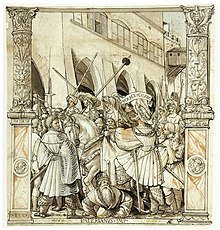
The Humiliation of Emperor Valerian by
Shapur I
, pen and ink,
Hans Holbein the Younger
, ca. 1521
Some modern scholars believe that, contrary to Lactantius’
account, Shapur I
sent Valerian and some of his army to
the city of Bishapur
where they lived in relatively good
condition. Shapur used the remaining soldiers in engineering and development
plans. Band-e Kaisar (Caesar’s dam) is one of the remnants of Roman
engineering located near the ancient city of
Susa. In all the stone carvings on Naghshe-Rostam, in Iran, Valerian
is respected by holding hands with Shapur I, in sign of submission.
It is generally supposed that some of
Lactantius
‘ account is motivated by his desire
to establish that persecutors of the Christians died fitting deaths; the story
was repeated then and later by authors in the Roman Near East “fiercely hostile”
to Persia.
Other modern scholars tend to give at least some credence to
Lactantius’ account.
Valerian and Gallienus’ joint rule was threatened several
times by
usurpers
. Despite several usurpation attempts,
Gallienus secured the throne until his own assassination in 268.
Owing to imperfect and often contradictory sources, the
chronology and details of this reign are very uncertain..
A thunderbolt is a symbolic representation of incidents of observed
lightning
when accompanied by a loud
thunderclap
. In its original usage the word may
also have been a description of meteors, or, as
Plato
suggested in
Timaeus
,of the consequences of a close
approach between two planetary cosmic bodies, though this is not currently the
case. As a divine manifestation the thunderbolt has been a powerful symbol
throughout history, and has appeared in many
mythologies
. Drawing from this powerful
association, the thunderbolt is often found in military symbolism and
semiotic
representations of electricity.
In mythology

Neo-Attic
bas-relief sculpture of
Jupiter
, holding a thunderbolt in
his right hand; detail from the Moncloa
Puteal
(Roman, 2nd century),
National Archaeological Museum, Madrid
Lightning plays a role in many mythologies, often as the weapon of a
sky god
and
weather god
. As such, it is an unsurpassed
method of dramatic instantaneous retributive destruction: thunderbolts as divine
weapons can be found in many mythologies.
- in the
Hebrew Bible
, the word for “arrow”,
khets חֵץ, is used for the “arrows” of
YHWH
/Elohim,
which are represented as lightnings in
Habakuk
3:11, but also as general
calamities inflicted on men as divine punishment in
Deuteronomy
32:42,
Psalm 64
:7,
Job
6:4, etc.
-
Indo-European traditions
- In Hittite
(and
Hurrian
) mythology, a triple
thunderbolt was one symbol of
Teshub
(Tarhunt).
-
Vedic religion
(and later
Hindu mythology
) the god
Indra
is the god of lightning. His main
weapon is the thunderbolt (Vajra).
- In
Greek mythology
, the thunderbolt is a
weapon given to Zeus
by the
Cyclops
. Based on this, in
Roman mythology
, the thunderbolt is a
weapon given to
Jupiter
by the Cyclops, and is thus one
of the emblems of Jupiter, often depicted on Greek and Roman coins and
elsewhere as an eagle holding in its claws a thunderbolt which resembles
in form a bundle of crossed sticks.
- In
Celtic mythology
,
Taranis
is the god of thunder, in
Irish
,
Tuireann
.
- In
Germanic mythology
,
Thor
is specifically the god of thunder
and lightning, wielding
Mjolnir
.
- In
Turkish mythology
,
Bayülgen
creates the thuderbolts.
- In
Maya mythology
,
Huracan
is sometimes represented as three
thunderbolts.
- In Cherokee
mythology, the
Ani Hyuntikwalaski
(“thunder beings”) cause
lightning fire in a hollow
sycamore
tree.
- In
Ojibway
mythology, thunder is created by
the
Thunderbirds
(Nimkiig or Binesiiwag), which
can be both benevolent and malevolent to human beings.
- In Igbo mythology
, the thunderbolt is the
weapon of Amadioha
/Amadiora.
- In
Yoruba mythology
, the thunderbolt is the
weapon of Shango
.
In Christianity
The thunderbolt is a weapon and symbol associated with the
Antichrist
, in some Christian texts.
Thunderstones
The name “thunderbolt” or “thunderstone” has also been traditionally applied
to the fossilised
rostra
of
belemnoids
. The origin of these bullet-shaped
stones was not understood, and thus a mythological explanation of stones created
where a lightning struck has arisen.
In the modern world
The thunderbolt or lightning bolt continues into the modern world as a
prominent symbol; it has entered modern
heraldry
and military iconography.
- In iconography
- The thunderbolt is used as an electrical symbol.
- A thunderbolt is used in the logo of the Australian hard rock band
AC/DC
.
- In fiction
- The thunderbolt is the symbol seen on the chest of the costumes worn by
the DC Comics
characters
Captain Marvel
, the
Flash
, and
Static
.
- In the
Harry Potter
franchise, the scar on
Harry’s forehead is in the shape of a thunderbolt.
- In the novel
The Godfather
, “being hit with the
thunderbolt” is a Sicilian expression referring to a man being spellbound at
the sight of a beautiful woman. The novel’s emerging main character is
affected in this fashion and eventually marries a woman whose appearance
initially affects him in this way.
|





 the equivalent of Zeus
the equivalent of Zeus



